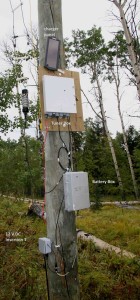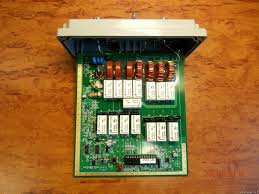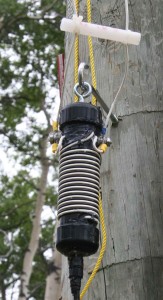- Home
- Registration
- Site Tools
- Articles
- Swap n Shop
- Contesting
- Grounding information for everyone
- History of the Central Alberta Amateur Radio Club
- CAARC owned Repeaters
- Club Repeater Info
- GMT Time Conversion Table
- VE/VA6 Incoming QSL Bureau
- Pine Lake Tornado Friday July 14, 2000.
- Amateur Radio to the Rescue
- CANWARN
- HAM Nation with Bob Heil K9EID
- Net info
- Events.
- ARES
- Links and On line study course.
- Field Day 2019
- Members D/L
- Forum/Swap and Shop
Remote antenna tuner
Remote tuners are offered by MFJ, LDG and others. Here is my brief review of the LDG RT-100 tuner.
I purchased the tuner new, at what I considered was a competitive price. As you can see from the photo I am using it to tune a horizontal loop antenna close to the feed-point.  The tuner is matching a short section of low loss open wire line and not a long section of coax.  The tuner requires 12V DC at low current so I powered it from a gel cell battery and a small solar trickle charger panel (CND$14). This remote solar power arrangement has been in operation for several months now without issue.
The tuner finds a match from 80 – 10 meters on the random length loop (~130m of #10 multi-strand insulated wire, 10m high).
I have found a few issues with tuning; i.e. failing to find a good match on a band or frequency. As per the instruction manual a tune can be “forced†by changing bands, re-tuning and then returning to the frequency you want to operate on.
The second issue noted is a de-tune with changing weather / moisture conditions. For example rain or heavy dew on the antenna may cause the antenna to re-tune. This does not often happen but it is inconvenient there is a re-tune cycle in the middle of a QSO.


I experimented with different baluns and found that a 4:1 air core balun worked best for me. This balun is very easy and inexpensive to make using parts from the hardware store.   The antenna is maintained at DC ground through the balun and tuner. (Yes, the ground wire should have been green…major fail !)

Using the remote tuner I was able to operate on SSB effectively on multiple bands with a single wire antenna using only 100 W. The loop antenna was found to be very quiet as a receive antenna. On 20m a signal barely audible on a dipole was perfectly Q5 on the loop antenna.
So if your opportunities for erecting antennas are restricted my experience shows that a multi band wire antenna with a remote tuner and one feedline can be an effective way to operate HF.
| Print article |


about 9 years ago
Great article Earl . Sometimes the pictures take a few minutes to show up in an article. Looks like they are fine now. Thanks for sharing your projects
Bob
Webmaster